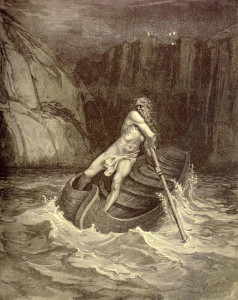
‘The Ninth Legion’ is a setting sourcebook by Paul Mitchener (Age of Arthur, Blood of the Gods) for Greg Stolze’s roleplaying game Reign: A Game of Lords and Leaders (learn more about this setting in our previous posts).
The River Styx and the Far Reaches
The parts of Arcadia beyond the Southern Plains and Fae Forests is truly strange. It is the abode of the gods, the dead, and demons. Few living mortals ever travel there. In order to travel to the Far Reaches, a mortal must first find the River Styx.
All mortals go there when they die, but there is another way for the living. Deep in Arcadia, those brave souls seeking the river may find a path leading to deeper and darker places, which takes a week or so to traverse. There may be dangers and perils on the path.
The poisoned waters of the River Styx wind round the Far Reaches in all directions, separating them from the mortal realms of Arcadia. At the river itself, the Styx and its shores are always in shadow. The near shores are haunted by shades of the angry dead, trying to take either coins or blood from visitors, depending on how deranged they are. These dead cannot cross the river and so reach the afterlife.
The only sure way to cross is in the barge of the ferryman, Charon, who can usually be seen on the river, wherever it is reached, and will arrive within minutes of being called. Swimmers or boats other than the ferryman’s vessel sink like a stone on the Styx. Birds trying to fly overhead (or those turned into birds through magic) find themselves unaccountably heavy and unable to fly once over the river.
The gods themselves swear binding oaths by the River Styx. To a mortal, the river’s waters are a deadly poison, even if merely briefly touched rather than imbibed. However, a side effect of touching the waters is a protection from future harm for the body part which made contact. For one who survives the poison, which is rare and improbable, this can be a potent gift. Complete submersion is invariably fatal, however.
The ferryman will only take those who can pay. The dead who have received proper funeral rites will have had a coin placed in their former body’s mouth; a version of this coin is the used after death for payment. Those souls who cannot pay the ferryman are doomed to haunt the banks of the Styx, or return to the mortal world, in the form of lemures.
For the living there is another payment- the golden bough of a magical elm tree found in the Heart of the Forest of Mists. Even for one of the living who makes it beyond the Styx, past mortal lands, getting out is another matter again.
Beyond the Styx are many strange lands, including both paradises and hells. Paradises include the four great cities of the Tuatha de Danaan, and the Elysian Fields or Mag Mell, the Plain of Joy, where the truly heroic or virtuous receive their final reward. The Asphodel Meadows are neither heaven nor hell, and the dead labor there much as in life until they are reborn, their memories wiped clean.
At the other extreme, the Far Reaches hold the Fields of Punishment, which echo with the screams of the damned. Here those who have offended the gods suffer ironic and creative tortures under the direction of the furies. Such tortures include Tantalus with his unreachable fruit tree and water, eternally hungry and thirsty, or Sisyphus with his unending labor with the boulder.
The most dangerous part of the Far Reaches is Tartarus, the prison of the primordial gods called titans or fomori. Tartarus is surrounded by both razor sharp mountains, and Phlegethon, the river of fire. Tisiphone, chief of the furies, watches the one entrance, a shrieking gate of adamant, from her iron tower. A fifty-headed hydra stands at the gate, and obeys Tisiphone’s commands.